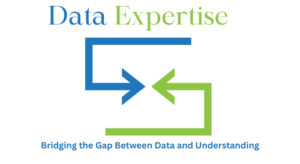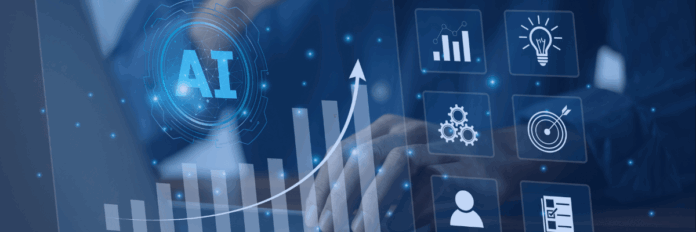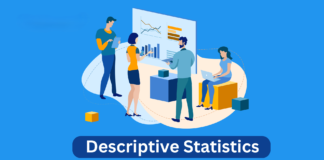In recent years, Generative AI for Data Analytics has emerged as one of the most powerful synergies in artificial intelligence. As data continues to fuel business innovation, organizations are turning to generative models to not only analyze existing data but also generate new insights, simulate scenarios, and enhance decision-making accuracy.
Unlike traditional analytics that rely purely on historical data, Generative AI (GenAI) leverages deep learning models like Generative Adversarial Networks (GANs) and Large Language Models (LLMs) to generate new, realistic data patterns. This ability revolutionizes how companies handle predictive modeling, customer segmentation, and business forecasting.
For example, financial analysts can now simulate market scenarios before making investment decisions, and healthcare researchers can generate synthetic patient data to train diagnostic models without compromising privacy.
This blog explores how Generative AI is redefining data analytics—covering its mechanisms, benefits, applications, real-world case studies, and future implications.
Understanding Generative AI
Generative AI is a subset of artificial intelligence that focuses on creating new data samples from existing data distributions. It doesn’t just interpret data—it creates new data points that mimic real-world patterns.
Some key generative AI models include:
- GANs (Generative Adversarial Networks): Used to generate images, videos, and data simulations.
- VAEs (Variational Autoencoders): Powerful for generating data distributions with minor variations.
- LLMs (Large Language Models): Such as GPT, BERT, and Claude, which generate human-like text and predictive insights.
These models rely on probabilistic reasoning and pattern recognition, enabling them to assist data analysts in identifying deeper correlations and generating actionable outcomes.
The Intersection of Generative AI and Data Analytics
Traditional data analytics focuses on descriptive, diagnostic, predictive, and prescriptive insights. However, Generative AI adds a fifth dimension — creative analytics. It allows systems to:
- Generate synthetic datasets for model training.
- Simulate outcomes for business forecasting.
- Fill gaps in missing or incomplete datasets.
- Suggest optimized solutions based on probabilistic learning.
In essence, Generative AI doesn’t replace human analysts—it enhances their analytical depth, transforming them into intelligent decision architects.
For instance, a retailer can use GenAI to simulate customer purchase behavior across multiple marketing campaigns, helping in strategic planning.
How Generative AI Works in Data Analytics
Generative AI models follow a data-driven learning loop:
- Data Collection: The model is trained on large volumes of structured or unstructured data.
- Pattern Recognition: The system identifies latent features and underlying trends.
- Data Generation: Based on learned distributions, it creates synthetic or predictive data.
- Evaluation: Generated data is compared to real-world outcomes to enhance model accuracy.
- Integration: Insights are embedded into dashboards, reports, or automation tools.
For example, in predictive analytics, generative AI can simulate thousands of possible outcomes for a marketing campaign and recommend the optimal strategy based on data probability.
Core Components of Generative AI for Data Analytics
Generative AI in analytics depends on several core technologies:
- Neural Networks: Deep architectures for pattern extraction.
- Probabilistic Models: Bayesian networks and Gaussian distributions for uncertainty estimation.
- Natural Language Processing (NLP): For analyzing text-heavy datasets such as reports, feedback, and logs.
- Synthetic Data Engines: To create new datasets for model validation.
- AutoML Platforms: That integrate generative algorithms with data visualization tools.
These components enable automation of analytical workflows, helping organizations gain faster, deeper, and more context-aware insights.
Real-World Applications of Generative AI in Data Analytics
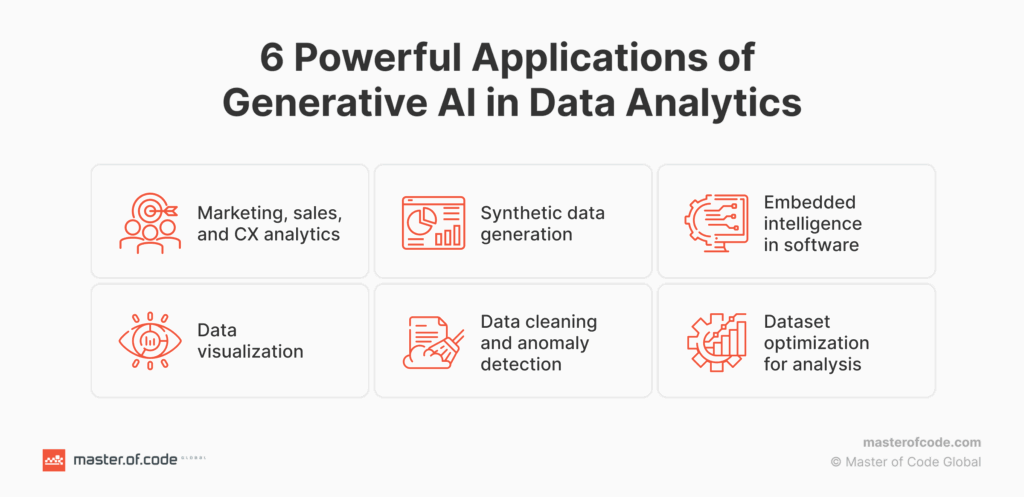
a. Predictive Analytics
Generative AI enhances forecasting models by simulating multiple future scenarios based on historical trends.
Example: In supply chain analytics, AI predicts demand fluctuations and generates alternative distribution strategies to reduce cost and waste.
b. Data Augmentation
When training datasets are small or imbalanced, GenAI generates additional synthetic samples to improve model accuracy.
Example: Healthcare researchers generate synthetic X-ray images to improve diagnostic AI performance.
c. Financial Modeling
Banks and investment firms use generative AI for risk modeling, portfolio optimization, and fraud detection by generating potential threat patterns.
d. Customer Analytics
Marketers use generative AI to build behavioral personas, simulate buying patterns, and create personalized experiences for target segments.
e. Natural Language Reporting
Tools like ChatGPT automate data storytelling — converting raw datasets into human-readable insights, executive summaries, and visualizations.
f. Data Cleaning and Completion
Generative models intelligently fill missing values, correct anomalies, and enhance data quality before analytics processing.
Advantages of Using Generative AI for Data Analytics
- Scalable Insight Generation: Automates data interpretation across large datasets.
- Enhanced Decision Accuracy: Reduces human bias through probabilistic reasoning.
- Synthetic Data Creation: Enables privacy-safe analytics without real-world exposure.
- Time Efficiency: Automates repetitive analytical processes.
- Cost Reduction: Minimizes dependency on expensive data collection.
- Explainable AI: Provides reasoning behind generated insights.
Challenges and Limitations
Despite its advantages, generative AI faces key challenges:
- Data Bias: Synthetic data may reflect biases in the original dataset.
- Complex Model Training: Requires massive computational resources.
- Data Privacy Concerns: Generated outputs might still expose sensitive patterns.
- Interpretability: Generated outcomes can be difficult to explain to non-technical stakeholders.
- Ethical Risks: Unchecked model use can lead to misinformation or manipulation.
To overcome these, organizations are investing in ethical AI frameworks and governance protocols to ensure transparent model usage.
Tools and Frameworks Powering Generative AI in Analytics
Here are some of the most widely used tools in this domain:
- OpenAI GPT Models – For automated data interpretation.
- Google Vertex AI – For managing generative pipelines.
- Databricks GenAI Suite – Integrating generative analytics workflows.
- Hugging Face Transformers – For NLP-based data generation.
- AWS Bedrock – To deploy generative AI in enterprise analytics environments.
- Synthesia AI – For generating data-rich video analytics reports.
Future of Generative AI for Data Analytics
By 2030, over 80% of enterprises are expected to integrate Generative AI into their analytics workflows. The future will see:
- Cognitive analytics systems that continuously learn and evolve.
- Autonomous data platforms capable of making real-time strategic decisions.
- Cross-domain AI agents that link customer behavior with operational intelligence.
Generative AI is not just transforming analytics—it’s redefining how business intelligence operates in a world driven by adaptability and precision.
Deep Dive: How Generative AI is Revolutionizing the Data Analytics Pipeline
In traditional analytics, data pipelines rely heavily on structured data ingestion, transformation, and feature engineering — all of which are labor-intensive. However, Generative AI for data analytics redefines this process by automating data synthesis and analysis using foundation models and large-scale learning architectures.
For example:
- Synthetic data generation using diffusion models and GANs (Generative Adversarial Networks) helps in building datasets when privacy constraints prevent access to real-world data.
- LLMs (Large Language Models) can interpret queries in natural language and automatically generate SQL statements or Python scripts for data processing.
- Transformer-based architectures enable the model to learn relationships across multidimensional data fields — structured or unstructured — improving correlation and causation understanding.
This level of automation allows organizations to shorten analysis time from weeks to minutes, especially in industries like finance, healthcare, and manufacturing where data variety and volume are massive.
Architectural Blueprint: How Generative AI Embeds within the Data Stack
Implementing generative AI for data analytics requires a hybrid architecture combining data lakes, ML pipelines, and LLM-based intelligence layers.
Core Components:
- Data Ingestion Layer – Captures data from multiple sources (APIs, IoT sensors, CRM systems).
- Feature Store + Synthetic Data Generator – Uses GANs, VAEs, or diffusion models to enhance limited datasets.
- Model Training and Fine-Tuning Layer – Employs large-scale LLMs such as GPT, Claude, or Gemini, fine-tuned with domain-specific data.
- Prompt-Oriented Analytics Layer – Enables analysts to use prompts instead of code (e.g., “Compare quarterly revenue performance between Q1 and Q2”).
- Visualization and Insight Generation Layer – Outputs dashboards, charts, and narratives generated automatically.
Example:
A retail company integrating OpenAI’s GPT-4 with Snowflake’s data warehouse can automatically generate business insights based on natural language prompts. The analyst doesn’t need SQL knowledge; the model interprets the question, retrieves relevant data, and crafts a human-readable report.
Advanced Real-Time Use Cases
a. Financial Risk Modeling
Banks and investment firms use Generative AI for data analytics to simulate extreme market scenarios using synthetic data. This allows risk teams to test their trading models against rare or unpredictable economic events that don’t exist in historical datasets.
b. Healthcare Predictive Diagnostics
Generative models can simulate patient records to identify likely outcomes for treatment plans while maintaining HIPAA compliance. For instance, researchers at MIT have used synthetic patient data to improve cancer diagnosis prediction accuracy by 13%.
c. Supply Chain Optimization
By combining real-time IoT sensor data with generative simulations, logistics firms can anticipate disruptions (e.g., port congestion, weather delays) and simulate optimal routing strategies before the problem occurs.
d. Marketing Analytics
In marketing, generative AI can create “synthetic customer personas” to test campaigns on simulated demographics, reducing the need for costly A/B testing.
Integrating Generative AI with Business Intelligence Tools
Modern BI tools like Power BI, Tableau, and Looker are integrating generative capabilities to automate data storytelling and visualization.
Example Workflow:
- The user inputs a prompt such as “Show me sales growth trends for Q2 2024 in Southeast Asia.”
- The system retrieves the data, applies statistical transformations, and generates not only a chart but also a written narrative explaining the trend — powered by natural language generation (NLG).
This shift from manual dashboard design to intelligent narrative insights is what defines the next wave of AI-augmented analytics.
Challenges in Scaling Generative AI for Data Analytics
Despite its transformative potential, deploying generative AI for analytics at scale involves several technical and ethical hurdles.
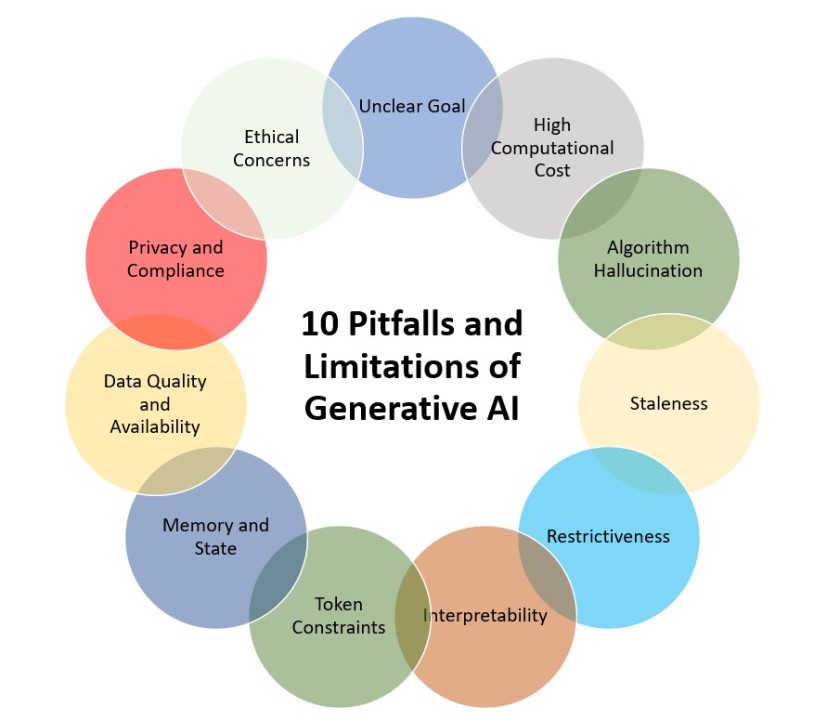
a. Data Quality and Hallucination
Generative models may produce inaccurate or biased insights when trained on noisy data. The solution lies in implementing data versioning and provenance tracking — ensuring that every dataset used in model training can be traced back to its origin.
b. Computational Costs
Training foundation models or maintaining fine-tuned LLMs for enterprise analytics requires substantial GPU and storage resources. Companies are mitigating this by adopting parameter-efficient fine-tuning (PEFT) and low-rank adaptation (LoRA) techniques to reduce compute overhead.
c. Model Interpretability
Unlike traditional regression or decision tree models, generative systems operate as black boxes. Tools like LIME, SHAP, and Captum are now used to explain how generative AI arrives at particular conclusions, enhancing transparency and trust.
d. Data Security and Privacy
When used for analytics, generative AI can inadvertently expose sensitive data patterns. Techniques like federated learning and differential privacy are critical to ensure secure collaborative model training without raw data exchange.
Future Directions: Towards Autonomous Data Analytics Systems
The convergence of AutoML, LLMs, and Generative AI is paving the way for autonomous analytics platforms — systems that can independently:
- Identify relevant data sources
- Clean and structure data
- Generate insights
- Visualize results
- Recommend actions
These systems represent the ultimate form of decision intelligence, where human analysts shift from data wrangling to strategic interpretation.
Example:
Google Cloud’s Vertex AI and Databricks’ MosaicML are moving toward this vision — integrating data management, generative models, and predictive analytics into unified environments.
Ethical and Regulatory Frameworks
As generative AI becomes more deeply embedded in data analytics, governance frameworks must evolve.
The EU AI Act (2024) and NIST AI Risk Management Framework are shaping compliance standards for responsible model deployment.
Key areas include:
- Explainability: Ensuring AI-driven analytics can justify decisions.
- Bias Mitigation: Actively identifying and correcting demographic or contextual bias.
- Transparency: Documenting datasets, models, and decision logic.
- Human Oversight: Keeping humans in the loop for critical business decisions.
Companies that adopt ethical AI analytics practices early will not only comply with regulations but also build long-term trust and brand credibility.
The Competitive Edge: Why Businesses Should Adopt Generative AI in Analytics Now
Organizations adopting Generative AI for data analytics are already reporting 20–40% faster insight generation and 30% lower analytical costs due to reduced manual effort.
In a 2025 McKinsey report, over 60% of top-performing enterprises identified AI-enhanced analytics as a critical driver of operational efficiency and innovation.
By transforming unstructured data into intelligent forecasts and narratives, generative AI bridges the gap between data abundance and decision intelligence — unlocking value at every stage of the data lifecycle.
Real-Time Industry Examples
- Healthcare: Philips and IBM Watson Health use GenAI to simulate disease progression and optimize treatment pathways.
- Retail: Amazon uses generative AI to model customer demand and personalize product recommendations.
- Finance: JP Morgan integrates GenAI for fraud detection and credit risk simulations.
- Manufacturing: Siemens uses AI-driven simulations for quality prediction and predictive maintenance.
Ethical and Security Considerations
With power comes responsibility. As generative AI becomes central to analytics, ethical compliance is crucial. Companies must ensure:
- Data Anonymization for all synthetic datasets.
- Model Transparency to prevent algorithmic bias.
- Governance Protocols for monitoring data generation pipelines.
- Human Oversight in critical decision-making.
These principles ensure trustworthy, accountable, and explainable AI systems.
Final Thoughts
Generative AI for Data Analytics represents a paradigm shift in how organizations interpret and act on information. It bridges the gap between data exploration and insight generation, enabling businesses to operate intelligently even in uncertain conditions.
As AI-driven analytics continues to evolve, the future will belong to those who can blend creativity with computation, leveraging generative power not just for predictions, but for innovation itself.Generative AI is not merely the future of analytics — it is the foundation of intelligent decision-making in the data-first world.
FAQ’s
What is generative AI in data analytics?
Generative AI in data analytics refers to the use of AI models that can generate new data, insights, or predictions by learning patterns from existing datasets, enabling smarter and more automated decision-making.
Can Genai be used for data analysis?
Yes, Generative AI (GenAI) can be used for data analysis by automating data cleaning, generating insights, and creating predictive models, making analytics faster and more efficient.
How is AI used in data analytics?
AI is used in data analytics to automate data processing, identify patterns, make predictions, and generate actionable insights, helping businesses make smarter, data-driven decisions.
What are the three types of generative AI?
Three common types of generative AI are:
Generative Adversarial Networks (GANs) — where two neural networks compete (a generator vs a discriminator) to produce realistic synthetic data.
Variational Autoencoders (VAEs) — which encode data into a latent space and then decode it back, allowing new data generation by sampling from that latent space.
Diffusion Models & Transformer-based Models — diffusion models generate data by iteratively reversing noise, and transformers (large language models etc.) generate new content (text, code, images) based on learned context.
What is the difference between data analytics and GenAI?
Data analytics focuses on examining existing data to uncover patterns, insights, and trends, while Generative AI (GenAI) goes a step further by creating new data, content, or insights using advanced AI models trained on large datasets.
